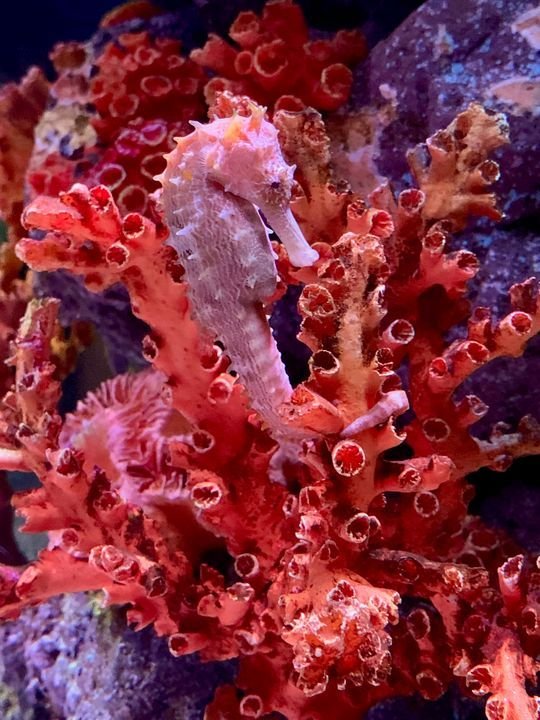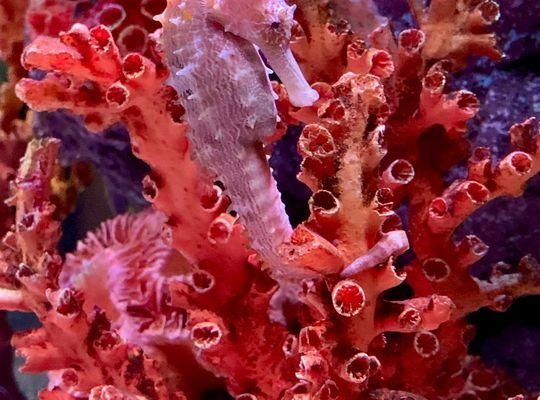
Understanding Seahorses and Their Habitat
Seahorses are unique creatures that belong to the Syngnathidae family, which also includes pipefish. Unlike traditional fish, they have a horse-like head and a prehensile tail that allows them to anchor themselves to corals and seagrasses. They’re mostly found in shallow waters, often near coral reefs or seagrass beds, where they can easily blend in with their surroundings.
Their natural habitat is typically warm, shallow seas and estuaries, which provide not just shelter but also food. Seahorses thrive on small crustaceans and plankton, which they catch with their small, tube-like mouths. Now, you might be wondering how this environment relates to coral reefs. Well, coral reefs are bustling ecosystems teeming with marine life, and understanding how seahorses fit into that picture is vital for anyone considering tank setup or conservation efforts.
Seahorse Compatibility with Coral Reefs
So, let’s get straight to the point: Are seahorses compatible with coral reefs? The answer is yes, but with some caveats. Seahorses can coexist with coral as long as the environment is carefully managed. Since they are relatively slow swimmers, they benefit from areas with plenty of hiding spots—think of branches, coral formations, and even the nooks of seagrass.
Here’s the thing: not all corals are created equal. Soft corals, like button polyps or leathers, tend to be more forgiving for seahorses than hard corals, which can have sharp edges or stinging tentacles. If you’re setting up a reef tank, opt for gentler species, ensuring your seahorses can navigate safely without harm.
Caring for Seahorses in a Reef Tank
If you’re considering creating a reef tank that includes seahorses, it’s important to keep a few care tips in mind:
- Tank Environment: A well-structured tank with plenty of live rock and safe coral is essential. This provides hiding spots and a more natural habitat for seahorses.
- Water Quality: Seahorses are sensitive to water conditions. Regular maintenance and monitoring of water parameters (like salinity and temperature) are crucial to keep them healthy.
- Feeding: These creatures rely on a diet of live or frozen foods like brine shrimp or copepods. Ensure proper feedings that match their needs while coordinating with any other reef inhabitants.
Caring for seahorses in a reef tank can be a rewarding experience when you take the time to understand their needs and maintain a balanced environment.
Potential Challenges When Keeping Seahorses with Coral
While seahorses can live in reef tanks, there are some challenges you should be aware of.
Predation Risks: Some fish species may see seahorses as a tasty snack. Caution is needed to avoid aggressive or larger fish that thrive in reef habitats.
Coral Aggression: Certain hard corals, especially those with stinging cells, can pose a risk. Remember, seahorses don’t defend themselves as other fish do; they rely on camouflage and concealment.
Stress Levels: Rapid water changes or poor tank mates can lead to increased stress, potentially making your seahorses sick. Always monitor their behavior closely.
Let’s face it—keeping seahorses in a reef environment can feel like walking a tightrope. You need to balance the beauty of coral with the delicate nature of your new friends.
Creating Harmony in Your Reef Tank
To ensure a peaceful coexistence in your tank, focus on creating a balanced environment. Here are a few ways to foster harmony:
- Tank Mates: Choose docile fish that won’t harass or outcompete seahorses for food. Look for species known for peaceful behavior.
- Plenty of Hiding Spots: Incorporate lots of live rock, soft corals, and plants to give seahorses a safe haven.
- Monitor Behavior: Keep an eye on how different species interact. If you notice aggression, be prepared to rearrange or relocate fish.
By taking these precautions, you’ll help ensure that your seahorse reef remains a safe and welcoming environment.
Tools and Techniques for Monitoring Your Reef
If you want to create a thriving reef tank that includes seahorses, here are some tools and techniques that can help:
- Aquarium Test Kits: Regularly test water parameters like pH, salinity, and ammonia levels to ensure a safe environment.
- Water Change Schedule: Implement a consistent water change routine to maintain high water quality.
- Feeding Regimen: Establish a regular feeding schedule tailored to your seahorses’ needs to keep them healthy.
Honestly, investing in the right tools makes a world of difference. You’ll build your confidence while providing a safe and nurturing environment for your aquatic friends.
Final Thoughts: The Joy of Seahorse Reef Compatibility
In conclusion, setting up a seahorse reef can be a beautiful adventure full of joy, wonder, and learning opportunities. While these unique fish can coexist with coral, it boils down to understanding their needs and behaviors. Remember, it’s about creating a balanced habitat that embraces the charm of seahorses while respecting the vibrant life of coral reefs.
Don’t shy away from experimenting and learning along the way. Your seahorse reef can become a thriving ecosystem where these delicate creatures flourish, reminding you daily of the wonders beneath the waves. So, whether you’re sprucing up a home aquarium or exploring ways to protect their natural habitats, your efforts can make a meaningful impact. Happy reef-keeping!

